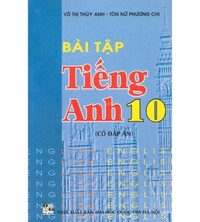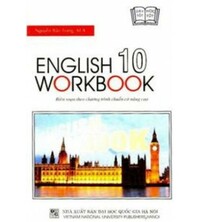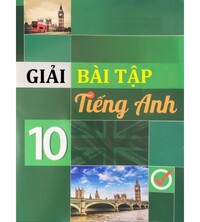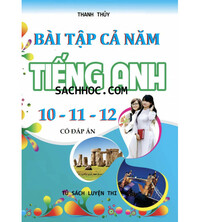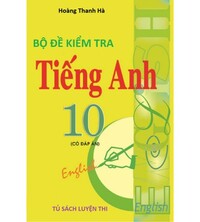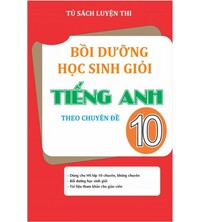7.8. Speaking - Unit 7. Cultural diversity - SBT Tiếng Anh 10 English Discovery
1. Match the foods to the correct pictures. 2. Complete the passages using the words below. 3. Rearrange the words to make questions about dishes. 4. Match the phrases / sentences (a-j) with the functions (1-5) below.
Bài 1
1. Match the foods to the correct pictures.
(Ghép các loại thực phẩm vào tranh cho đúng.)
spring rolls sweet soup
stewed chicken soup balut
stir-fried water spinach egg coffee
grilled pork noodles bánh mì
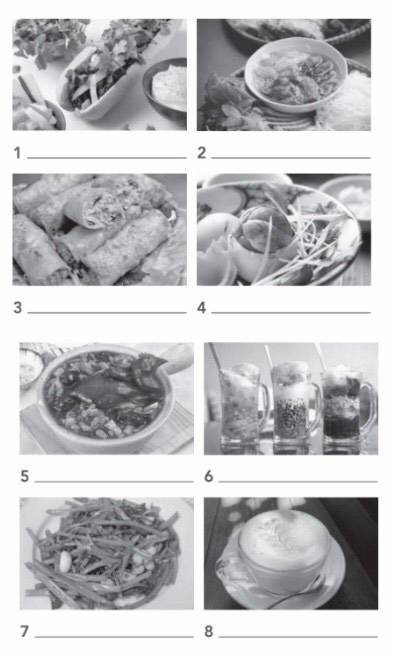
Lời giải chi tiết:
|
1. bánh mì |
2. grilled pork noodles (bún thịt nướng) |
3. spring rolls (nem rán) |
4. balut (trứng vịt lộn) |
|
5. stewed chicken soup (súp gà hầm) |
6. sweet soup (chè) |
7. stir-fried water spinach (rau muống xào) |
8. egg coffee (cà phê trứng) |
Bài 2
2. Complete the passages using the words below.
(2. Hoàn thành các đoạn văn bằng cách sử dụng các từ dưới đây.)
make ingredients first besides
To (1) _______spring rolls, we need minced pork, carrots, onions and eggs. (2) _____, we can add shrimps, crab meat, squid and so on to make seafood spring rolls. (3) _______, all the (4) ______ are mixed and wrapped with rice paper.
complete fed up fillings
You can never get (5) ______ with bánh mì. A I traditional version goes with pâté and fried eggs as (6) ______. Other choices are sausages, grilled beef, chicken and pork. And a bánh mì wouldn't be (7) _______ without some slices of cucumber, tomato, pickled vegetables, mayonnaise and chilli sauce.
look for yummy favoured
Baluts (Trứng vịt lộn) are (8) ______ by many Vietnamese people, (9) _____ they are not only (10) ______ but also rich in nutrients. However, they have scared many tourists because of their (11) ______.
why mix ture serve tastes
Sweet soup (Chè) can (12) ______ as a dessert, but a lot of people like to have a glass of it in a hot summer afternoon. One popular type of chè is a (13) _____ of different beans and it (14) _______ really sweet. That's (15) _________ we like to add a lot of ice to it and it's perfect for summer.
comes versions
Egg coffee normally (16) ________ in warm and cold (17) ________.
Lời giải chi tiết:
|
1. make (làm) |
2. Besides (Bên cạnh đó) |
3. First (đầu tiên) |
4. ingredients (nguyên liệu) |
5. fillings (nhân) |
6. complete (hoàn thành) |
|
7. fed up (chán) |
8. favoured (ưu chuộng) |
9. for (bởi vì) |
10. yummy (ngon) |
11. look (vẻ ngoài) |
12. serve (phục vụ) |
|
13. mixture (trộn) |
14. tastes (vị) |
15. why (tại sao) |
16. versions (phiên bản) |
17. comes (đi kèm) |
To (1) make spring rolls, we need minced pork, carrots, onions and eggs. (2) Besides, we can add shrimps, crab meat, squid and so on to make seafood spring rolls. (3) First, all the (4) ingredients are mixed and wrapped with rice paper.
(Để (1) làm chả giò, chúng ta cần thịt lợn băm, cà rốt, hành tây và trứng. (2) Ngoài ra, chúng ta có thể thêm tôm, thịt cua, mực,… để làm chả giò hải sản. (3) Đầu tiên, tất cả (4) nguyên liệu được trộn đều và gói bằng bánh tráng.)
You can never get (5) fillings with bánh mì. A traditional version goes with pâté and fried eggs as (6) complete . Other choices are sausages, grilled beef, chicken and pork. And a bánh mì wouldn't be (7) fed up without some slices of cucumber, tomato, pickled vegetables, mayonnaise and chilli sauce.
(Bạn không bao giờ có thể nhận được (5) nhân với bánh mì. Một phiên bản truyền thống đi kèm với pa tê và trứng chiên là (6) đã hoàn thành. Các lựa chọn khác là xúc xích, thịt bò nướng, thịt gà và thịt lợn. Và một chiếc bánh mì sẽ không (7) chán nếu không có vài lát dưa chuột, cà chua, rau ngâm, sốt mayonnaise và tương ớt.)
Baluts (Trứng vịt lộn) are (8) favoured by many Vietnamese people, (9) for they are not only (10) yummy but also rich in nutrients. However, they have scared many tourists because of their (11) look.
(Trứng vịt lộn được nhiều người Việt Nam (8) ưa chuộng, (9) bởi vì nó không chỉ (10) ngon mà còn giàu chất dinh dưỡng. Tuy nhiên, chúng đã khiến nhiều du khách sợ hãi vì vẻ ngoài (11) của chúng.)
Sweet soup (Chè) can (12) serve as a dessert, but a lot of people like to have a glass of it in a hot summer afternoon. One popular type of chè is a (13) mixture of different beans and it (14) tastes really sweet. That's (15) why we like to add a lot of ice to it and it's perfect for summer.
(Chè có thể (12) dùng như một món tráng miệng, nhưng rất nhiều người thích nhâm nhi một ly trong một buổi trưa hè nóng nực. Một loại chè phổ biến là trộn (13) loại đậu khác nhau và (14) vị rất ngọt. Đó là (15) lý do tại sao chúng tôi thích thêm nhiều đá vào nó và nó hoàn hảo cho mùa hè.)
Egg coffee normally (16) versions in warm and cold (17) comes.
(Cà phê trứng thông thường (16) phiên bản ấm và lạnh (17) đi kèm.)
Bài 3
3. Rearrange the words to make questions about dishes.
(Sắp xếp lại các từ để đặt câu hỏi về các món ăn.)
1. exactly / is / balut / What/?
2. is / balut / How / prepared /?
3. balut / types / some / of/ different / are/ What/?
4. people / with / often / eat / balut /do / What/?
5. Vietnamese /do /people / balut / Why / like?
Lời giải chi tiết:
1. What is balut exactly?
(Trứng vịt lộn chính xác là gì?)
2. How is balut prepared?
( Balut được chuẩn bị như thế nào?)
3. What are some different types of balut ?
(Một số loại trứng vịt lộn khác nhau là gì?)
4. What do people often eat with balut?
(Mọi người thường ăn gì với trứng vịt lộn?)
5. Why do Vietnamese people like balut?
(Tại sao người Việt Nam thích trứng vịt lộn?)
Bài 4
4. Match the phrases / sentences (a-j) with the functions (1-5) below.
(Nối các cụm từ / câu (a-j) với các chức năng (1-5) dưới đây.)
1. To introduce the food
2. To introduce the first point
3. To introduce another point
4. To give recommendation
5. To end your talk
a. Today, I would like to talk about ...
b. I'll start off by describing this food.
c. I will be telling you about ...
d. So that's a traditional food in my country.
e. Now, let's see how this food is made.
f. I really recommend this food.
g. Let's start with its look.
h. That's some information about ...
l. So why do so many people love this food?
j. When it comes to the taste, ...
Lời giải chi tiết:
|
1. a; c |
2. b; g |
3. l; e |
4. f; j |
5. d; h |
1. To introduce the food: (Giới thiệu món ăn)
a. Today, I would like to talk about … (a. Hôm nay, tôi muốn nói về …)
c. I will be telling you about ... (c. Tôi sẽ kể cho bạn nghe về …)
2. To introduce the first point: (Giới thiệu điểm đầu tiên)
b. I'll start off by describing this food. (b. Tôi sẽ bắt đầu bằng cách mô tả món ăn này.)
g. Let's start with its look. (g. Hãy bắt đầu với giao diện của nó.)
3. To introduce another point (Để giới thiệu một điểm khác)
l. So why do so many people love this food? (l. Vậy tại sao nhiều người lại yêu thích món ăn này?)
e. Now, let's see how this food is made. (e. Bây giờ, chúng ta hãy xem thực phẩm này được làm như thế nào.)
4. To give recommendation (Đưa ra lời giới thiệu)
f. I really recommend this food. (f. Tôi thực sự khuyên bạn nên thử món ăn này.)
j. When it comes to the taste, …(j. Khi nói đến hương vị, …)
5. To end your talk (Để kết thúc buổi nói chuyện của bạn)
d. So that's a traditional food in my country. (d. Vì vậy, đó là một món ăn truyền thống ở đất nước của tôi.)
h. That's some information about ... (h. Đó là một số thông tin về …)
Search google: "từ khóa + timdapan.com" Ví dụ: "7.8. Speaking - Unit 7. Cultural diversity - SBT Tiếng Anh 10 English Discovery timdapan.com"
